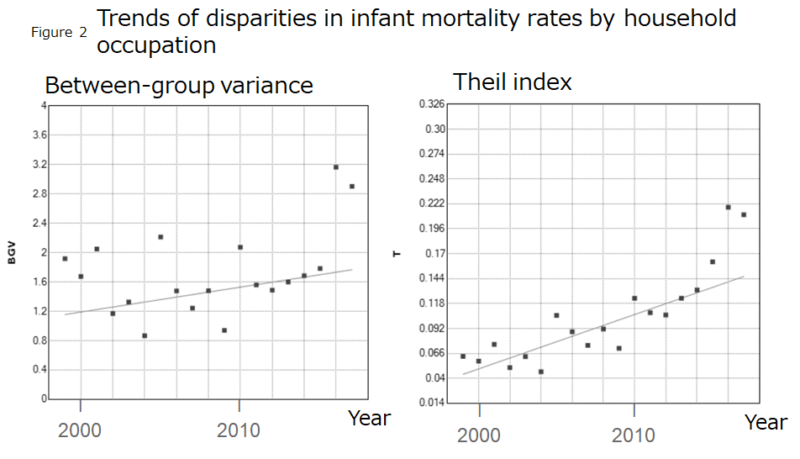2 times higher for farming households, 6.5 times higher for unemployed households
Disparities in infant mortality rates in Japan between prefectures have been recently increasing, but there have been few studies focusing on the disparities between occupations. This study used government-published data to compare infant mortality rates by primary household work. Results showed that the average infant mortality rate from 1999 to 2017 was 2 times higher for farming households and 6.5 times higher for unemployed households as compared to households with members who worked in companies with 100 or more workers. Furthermore, disparities in infant mortality rate between occupations have increased over the past 19 years. Additionally, disparities in infant mortality rate between occupations tended to be smaller in prefectures where the population density was low and the percentage of farmers was high. Disparities in infant mortality rate between occupations was shown to be increasing in Japan, which has one of the lowest infant mortality rates in the world. Background factors may include occupational or family environment, economic circumstances, and accessibility to medical institutions. Further investigations need to be conducted to elucidate the causes of these increasing disparities. Additionally, a local community that protects pregnant women and children needs to be built.

Background
Disparities in infant mortality rates in Japan between prefectures have been recently increasing. However, there are few studies focusing on disparities between occupations. The mechanism for supporting mothers and children during the perinatal period differs depending on occupation. For example, it is difficult to apply the Labor Standards Act to farmers and self-employed individuals due to employment characteristics, and it is difficult to obtain support such as maternity leave and childcare leave. Therefore, we focused on the primary household work type and analyzed the trends in infant mortality rates.
Methods
- Prefectures all over Japan
- We used data from demographic surveys on the number of infant deaths and births by prefecture and primary household work, and conducted a multi-level analysis that considered the hierarchical structure of the time-series data. Data from 19 years, from 1999 to 2017, were used. We calculated a disparity index and investigated how the disparities in infant mortality rates by occupation changes during this period. Furthermore, we used population density and farmer percentage data for each prefecture and investigated their associations with infant mortality rates by occupation.
- Primary household work: the work of the highest-income household at the time of birth. The following seven types of work types were used:
- Farming household: agriculture only, or agriculture and other work
- Self-employed household: individually managed freelance business, commerce/industry, service work, etc.
- Regular worker household (I): companies, private shops, etc. with 100 or less employees (excluding government offices)
- Regular worker household (II): regular worker households that do not fall under “Regular worker household (I)” and company organization officials
- Other household: other jobs that do not fall under the above categories (includes employees working on a daily basis or on contracts lasting less than a year)
- Unemployed household: households with no workers
- Unknown
Results
Infant mortality rates by primary household work were statistically significantly high in the following (ascending) order: regular worker household (II), regular worker household (I), self-employed household, farming household, other household, and unemployed household (Figure 1). The numbers in the figure show the factor by which the infant mortality rate was higher than that in the regular worker household (II), which had the lowest infant mortality rate.

There was also a widening tendency in the disparities of infant mortality rates between occupations, including unemployed households, from 1999 to 2017 (Figure 2). Furthermore, the disparities in infant mortality rates by occupation tended to be smaller in prefectures where the population density was low and the farmer percentage was high (Figure 3).


Conclusion
The results suggested that there were disparities in infant mortality rates by occupation, and that the disparities had an increasing trend. Japan has one of the lowest infant mortality rates in the world; nevertheless, there may still be disparities by occupation. Background factors contributing to this disparity may include differences in the employment environment surrounding women during the perinatal period (e.g., inability to take sufficient breaks), disparities in economic circumstances accompanying the employment circumstances, and the accessibility of medical institutions. Further research is needed to elucidate the causes for these disparities. Additionally, a local community that protects pregnant women and children must be built.
Published paper
Mariko Kanamori, Naoki Kondo, Yasuhide Nakamura. Infant mortality rates for farming and unemployed households in the Japanese prefectures: An ecological time trend analysis, 1999-2017. Journal of Epidemiology. February, 2020. https://doi.org/10.2188/jea.JE20190090 (OpenAccess)
Acknowledgments
This study was supported by JSPS Grant-in-Aid for Scientific Research (JP18H04071).



コメント